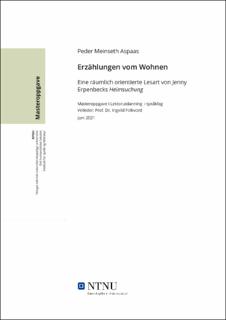| dc.description.abstract | Jenny Erpenbeck’s novel Heimsuchung (2007) challenges traditional reader expectations by the apparent lack of a protagonist in the narration. The text consists of 24 chapters that are only indirectly connected to each other, due to the fact that most of them take place at the grounds of a lake house in the Brandenburg countryside. Still, there is a continuity to this slow, timeless story that creates a gradual development and buildup of the grounds and the house, in the way that the different hopes, dreams, thoughts and fates of the characters are connected and related to the house and its surroundings. In this paper, the spatial dimension that emerges from Erpenbeck’s constellation of characters, intertwined with the fleeting and discontinuous time of the novel will be investigated in a twofold way:
In a first step, I approach the complex structure of the novel by identifying the fourth chapter of the book, “The Architect”, as a key chapter, due to the way it functions as a ‘viewing’; a display of the property. This makes it possible to develop a literary cartography; a reading which reveals how different places are presented and connected in the following chapters, how they relate to various characters, themes, and motives. The characters can hereby be conceived as vectors at different points in time, lending meaning to the property.
In a second step, I frame my reading of Erpenbeck’s novel through a combination of Boris Tomashevsky’s formalist approach to motives (2012) and James Corner’s use of mapping as it is developed in his essay “The Agency of Mapping” (1999). The overall aim is thereby to develop a systematic and performative analysis of Erpenbeck’s Heimsuchung that explores how the house and by extension the property, constitutes the centerpiece of the novel, the defining element that lends meaning to the story, and which in turn develops and unfolds in the interaction it has with the characters. Where the formalist theory helps pointing out the structure of the plot with its lack of a traditional protagonist, the Corner-inspired process of mapping makes it possible to discover how the novel itself unfolds around the development of the house, thereby building the particular spatial dimension that makes Heimsuchung so special. | |
